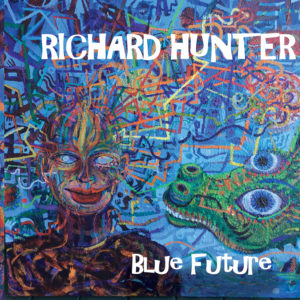
A bunch of great-sounding setups for harp that cost well under $1000
The fact is that gear for harp players has never offered better price for performance, and it’s entirely possible to put together a rig that sounds great–or will when you play harp well enough to get a good sound from the instrument–for well under $1000. The rigs described in this post will deliver great sounds for long after you pay the relatively (sometime remarkably) low entry fee. Most of them are also simple to set up and take down, in one case requiring only one (1) external connection.
Inexpensive, versatile, lightweight, and needs only one connection: Joyo American Sound and Bulletini mic
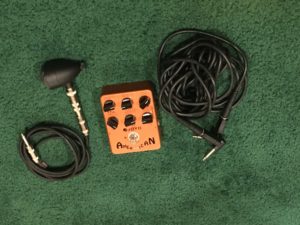
The Joyo American Sound pedal models the sound of Fender guitar amps, and it does a damn good job of it, especially when coupled with an excellent blues mic like the Bulletini. The Bulletini sells new for $189-229 without and with volume control respectively. The American Sound weighs about a pound, runs on either battery or a 9 volt DC input, and costs about $40 new, which makes it inexpensive, ridiculously easy to set up, and ridiculously easy to carry around. Take it to the gig in a shoulder bag, drop it on the stage, connect the mic to the input and connect the output to the PA, powered PA speaker, or keyboard amp, and you’re ready to rock. Don’t run it through a typical harp amp–the American sound is an amp modeler, not a distortion device, and it won’t sound good in front of a colorful-sounding tube amp. Use a linear amp–a PA, powered PA speaker, or keyboard amp–one that doesn’t add its own color to the sound. (Amps intended for acoustic guitar don’t seem to work so well for harp; I suspect they’re simply not as linear as the others.) Add a 10 foot 1/4″ cable for the mic to Joyo connection and a 20 foot 1/4″ cable for the Joyo to PA connection, and the kit is done.
I think every harmonica player who plays out at jams should have this setup. The setup time on stage is as close to zero as you can reasonably get, and the sound is good. If you already own a decent mic, at the price there’s nothing that comes close in terms of basic amped sounds.
Bulletini: $189-229
1/4″ cables (10 and 20 foot): $25-30
Joyo American Sound: $40
TOTAL: $255-$295
Add $300-400 for a keyboard amp or powered speaker if necessary. We recommend a keyboard amp or powered speaker with a 10″ or 12″ speaker, a minimum of 35-50 watts, and a line-out to take the signal from the amp/PS to a PA system. (If you have access to a PA system for practice and performance, you don’t need an additional loud-maker until the person who owns the PA denies you access.)
Traditional with a modern upgrade: Bulletini and 5 Watt tube amp
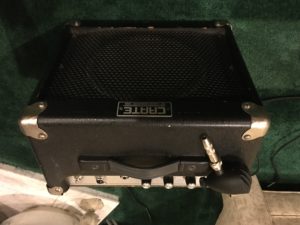
The sound of Chicago blues from the late 1940s and early 1950s is very much the sound of small tube amps coupled with cab dispatcher mics like the Shure Green Bullet and the Astatic JT-30. Modern equivalents that improve on the performance of earlier gear are the Bulletini mic and the Stage 5 amp. The Stage 5 produces a nicely traditional Chicago amped harmonica sound by itself, and it can be ordered with a lineout that allows it to send a full amped signal to the PA, making it a feasible setup for performing in a big room and/or with a loud band.
There are plenty of other choices. The essential sound of a small harp amp is the product of a 12AX7 series preamp tube coupled with a 6L6 power tube, a simple and effective circuit that’s found in lots of small tube amps. Add an 8″or 10″ speaker and you’re there. My modified Crate VC508, which has a single knob for gain and volume and one for tone, and its follow-on cosmetically embellished Crate siblings like the V5, V58, V5 Palomino, and so on, is a really nice example. Fender (Champ), Premier, Silvertone, VHT (Special 6), and Kalamazoo are examples of other brands based on this circuit that are known for being excellent performers with amped harp. Get one new or used and have a qualified amp tech install a line-out tapped after the amp section if you want to use it on loud gigs and jams.
There are choices for the mic as well. The Silverfish Silver Bullet is not as versatile a mic as the Bulletini, but it sounds very authentically blue through a 5 watt tube amp, with rugged build, builtin volume control and plenty of output, and costs less than half the price of a Bulletini with volume control. The Bulletini is a more flexible mic, meaning that it will produce a wider range of usable tones, and it sounds good with a wider range of rigs in my collection. The Bulletini also produces much bigger bass response than the Silver Bullet, which helps to big up the sound of a smaller speaker. In other words, while the Bulletini is my first choice, if your budget is tight, a Silver Bullet is going to give you a big for-real blues sound with a small tube amp. I own both. At an even lower price point, the Bottle o’ Blues produces a solid blues tone with a lot of bottom end. The difference in price can largely be attributed to build quality; you could drop an anvil on the Silver Bullet or the Bulletini and they’d probably still work, but the Bottle o’ Blues has a lightweight plastic shell that’s certainly crushable. That said, I owned a BoB for over 20 years (until it broke), and I used it when I wanted something very hot and blue.
A 5 watt tube amp won’t run on internal battery, so it requires an electric power connection. That said, all that needs to be done to set it up is to plug the electrical cord into the wall socket and plug the mic into the amp.
With regular maintenance, this setup will remain useful and satisfyingly musical for the life of a player. It is a very economical setup for a full-function performance-ready rig with a good sound for electric harp, and a line-out makes it an even more versatile performer.
Bulletini: $189-229 OR
Silverfish Silver Bullet: $130
1/4″ cable (10 feet): $10-15
Amp: (used) $150-250; (new) $275-325
(optional) 1/4″ cable for line-out ($20-25)
TOTAL: $315-595
Maximum mileage with minimum investment: Digitech RP500 and 2 mics
The Joyo American Sound is a simple amp modelng device. The Digitech RP500 is a multiFX device that includes amp modeling, compression, distortion, EQ, modulation FX, delay and reverb, and more in a very rugged device that includes a whole lot of foot control as well as a whole lot of sound potential. In terms of setup, the most important difference between the two is that the Joyo runs on batteries and therefore doesn’t need to connect to power. Otherwise, both use one input and one output to deliver the goods. (You can also go stereo with the RP500 if you like.) In terms of sounds, the most important difference is that the RP500 can do literally everything the Joyo does, but the Joyo doesn’t come close to producing the sheer variety of sounds that the RP500 can. Take a look at the list of FX in the second sentence in this paragraph; then note that the RP500 can do all of those at the same time, with lots of variations on each type of effect. Whew.
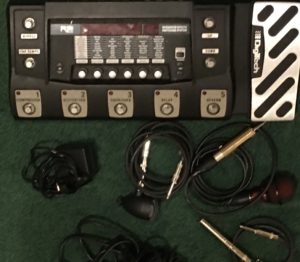
The RP500 went out of production recently. Used RP500s in good to excellent condition sell for $100-$150. An RP360XP, still in production, offers slightly less foot control but slightly improved sound quality, and sells new for $200. Used RP360XPs are available for about $100-150 as of this writing. My patch set for both devices, which sells for $50, is highly recommended if you want to get off to a great start out of the box.
To take full advantage of the extraordinary range of sounds in this device, I recommend that you budget for two mics: the Fireball V (at about $125) an the Bulletini at $180-229. The Fireball is great for transparent sounds with body and cutting power, for example smooth organ and rotating speaker sounds; the Bulletin is great for harder-edged, punchier stuff. Both together with an RP is a whole lot of colors to work with in a very performance-friendly package. Note that this setup, like the Joyo-based setup, requires a PA, powered PA speaker, or keyboard amp to make it loud.
Fireball V: $125
Bulletini: $189-229
XLR Cable plus inline transformer for Fireball V: $45
10 foot I/4″ cable for Bulletini: $10
20 foot 1/4″ cable for RP500 output: $20-25
Digitech RP500 (used/NOS): $100-150h
Digitech RP360XP (used/new): $150-200
Huntersounds patch set for Digitech RP500/360XP: $50
TOTAL: $490-660
Add $300-400 for a keyboard amp or powered speaker if necessary.
Big blues and rock bang for the buck: Bulletini plus modeling amp
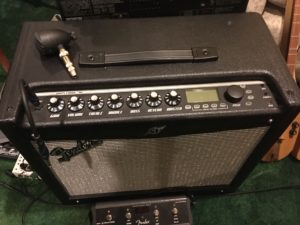
A modeling amp offers all the advantages of the traditional amped harp setup with the added flexibility and increased power available at lower price points with modeled amp technology. Examples of powerful, economical modeled amps include the Fender Mustang v.2 series (now discontinued except for the Mustang I v.2, but still widely available in very good or better condition used), the Line 6 Spider and Helix series, and a number of amps in various sizes by Vox (one of which, the discontinued DA5, is one of my favorite small amps), among others. These amps tend to be lighter than traditional tube amps with similar power specs, which pays off every time the amp is in motion. They almost always include a nice selection of harp-friendly FX like vibrato, rotating speaker, pitch shifting/octave doubling, and autowah among others. In other words, you get a good loud amp plus a lot of stuff you can use with it at a price much lower than you’d pay for the individual effects, let alone the amp.
A modeling amp with 100 watts of power, a 12″ speaker, and a line-out to take the signal to the PA for even more grunt (which are the minimum specs I’d look for in a performance-ready amp) can make a lot of noise, and a lot of different noises, all by itself, and even more with a PA in the picture. Such amps cost and weigh less than traditional tube amps with similar specs. If all you want to do with the thing is record, you can get a very small amp with 3-5 watts of power and a lot of amp models and FX in it for around $100. But it won’t have a line-out, so it’s not very effective for performing in even moderately loud situations. The small amps are great for bedroom playing and recording, not much else. Anyway, if you have a midrange modeling amp with the above specs you don’t need a smaller amp to get big sounds at low volume. Unlike a traditional tube amp, which has to be turned up to get the sound of those tubes pushing hard, when you put a sound together on a modeling amp, it’s the same sound no matter how loud you set the master volume. So you can use the same amp and get the same tones in low and high volume situations, in small rooms and large.
Pairing one of these amps with a Bulletini mic for blues and rock, and/or a Fireball V for country and rock, is a pretty obvious move. (We also get very good results for both harp and vocals with our Mustang III v.2 amp coupled with a Shure SM58 mic, as shown in the video.)
If you buy online, look at the pictures carefully. I recommend that you get an amp that has front panel controls like a “real” amp, i.e. knobs for volume, gain, treble/bass/mid EQ, etc. that look an act like the knobs you’ve used on amps since you discovered amps. That makes it a lot more familiar and easier to adjust sounds on the fly, which is something most players need to do every time they switch mics, and often when they go into a new room. (If you want to start right away with a bunch of great blues and rock setups, get a Fender Mustang I-V v.2 and my patch set for Fender Mustang v.2.)
This is the setup (with a Mustang III v.2) that I take to blues and rock performances when I’m not sure about access to a PA. I use it with a footswitch that turns stomp, mod FX, and delay on/off. (I have to deal with reverb on the front panel.) Because this amp includes a very nice, clean direct input model–a wire with gain–I can even use it with my Digitech RP500 or other amp modeler if I like, or as a vocal amp for smaller gigs. In short, it’s a lot of power and sound for a comparatively small investment.
Fender Mustang III v.2 (used): $200-250
Bulletini: $189-229
Fireball V: $125
Shure SM-58 $90
Huntersounds patchset for Fender Mustang (I/II/mini and III-V): $25/$40
XLR Cable plus inline transformer for Fireball V or Shure SM58: $45
10 foot I/4″ cable for Bulletini: $10
TOTAL: $340-$710
Joyo American Sound with pedalboard and FX
Since the Joyo American Sound is so inexpensive and good-sounding, it’s easy to spend a little to get some good FX to pair it with. For blues or rock harp, reverb and delay are the obvious first choices. I like a pitch shifter next, followed (or preceded in some cases) by a vibrato or rotary speaker effect, and that’s basically the chain that you see in the photo below. I’ll probably add an envelope filter, a/k/a an autowah, at some point.
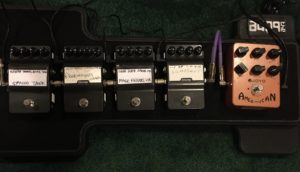
Notwithstanding that this setup does a lot more than the Joyo by itself, it’s not much harder to set up, adding only one electrical connection (for a 2-amp power supply that feeds all the pedals) to the stuff that has to be plugged in and out (assuming you actually have the boxes set up on a pedalboard so you don’t have to plug and unplug everything every time).
Joyo American Sound: $40
Bulletini: $189-229
4 used FX pedals at $50 each: $200
Pedalboard: $100
2 amp power supply: $10
1/4″ connectors: $10
TOTAL: $550-590
Add $300-400 for a keyboard amp or powered speaker if necessary.
So there you have it. Five setups that sound great for not a lot of money. I use all of these setups at one time or another, and all of them do their jobs well. The common factor in all of them is a great mic or two, so start with that and add pieces as necessary to make your sound big and shape it. Enjoy!
If you want to hear my patch sets in action, listen up here:
the 21st century blues harmonica manifesto in sound
Get it on Amazon
Get it on iTunes
the rock harmonica masterpiece
Get it on Amazon
Get it on iTunes
Tags In
Related Posts
Leave a Reply
You must be logged in to post a comment.
WHAT’S NEW
Categories
- Audio/Video
- Blog
- Blue Future
- Digitech RP Tricks and Tips
- Discography, CDs, Projects, Info, Notes
- Featured Video
- For the Beginner
- Gallery
- Hunter's Effects
- Hunter's Music
- Huntersounds for Fender Mustang
- Meet the Pros
- More Video
- MPH: Maw/Preston/Hunter
- My Three Big Contributions
- Player's Resources
- Pro Tips & Techniques
- Recommended Artists & Recordings
- Recommended Gear
- Recorded Performances
- Reviews, Interviews, Testimonials
- The Lucky One
- Uncategorized
- Upcoming Performances
- Zoom G3 Tips and Tricks
